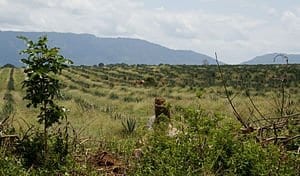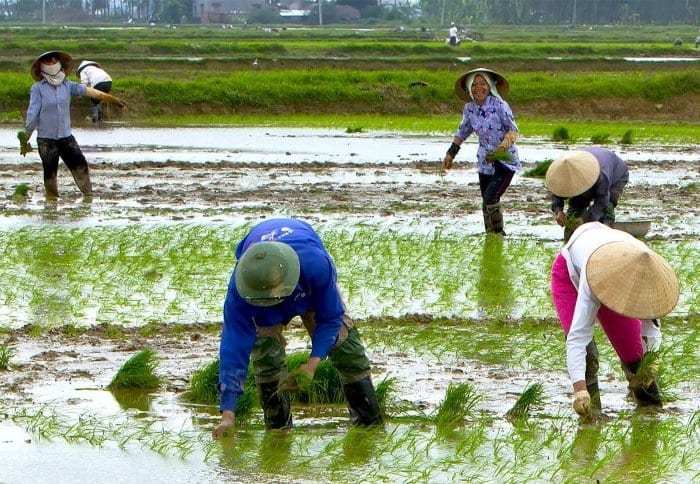
In Tanzania more frequent droughts and changing rainfall patterns are forcing subsistence farmers to adapt
Farmers need only survey their parched fields during the ever-intensifying dry seasons here to know climate change is happening.
Rain falls less frequently than it did a decade ago because of “destruction of the environment” says Sopian Kinyoge, a 27-year-old farmer. His older sister says rains are more fleeting from “cutting down of the trees.” Alfred Mofuga, 63, simply says, “I cannot know the ways of God.”
Even as the government of Tanzania invests in enhanced food production as a way to fight poverty and raise this country’s standard of living, it faces challenges on many fronts, including resistance from farmers reluctant to change their old ways, and the ongoing difficulty of adapting to a changing—and less predictable—climate.
The country’s official blueprint for reaching its goal of becoming a middle-income economy by 2025 hinges, in fact, on expanding its agricultural production, especially in Tanzania’s relatively fertile southern corridor, where better technologies and methods are expected to improve crop yields exponentially. Other nations have catapulted into the middle-income tier of countries, thanks to agricultural development’s “multiplier effect,” which allows countries to attack hunger and poverty simultaneously, says Tom Hobgood, who heads the U.S. Agency for International Development’s (USAID) $77-million Feed the Future program in Tanzania. That’s why USAID and Tanzania’s government are banking on agriculture for the nation’s future. Already agriculture comprises roughly one third of the country’s GDP and employs about three quarters of the population. And working in better climate resilience and nutrition will be essential to reducing poverty and ensuring Tanzania’s future.
Tanzania has ushered in a coterie of nongovernmental organizations (NGOs) to help support agriculture all along the supply chain. Enterprising firms promising better seeds, fertilizers and outputs are entering into the mix. And the government is also supporting the growth of large farms, too, which they say could employ technology to assist small farmers via local agreements. (Promoting the growth of larger farms, however, may simultaneously set the stage for tensions between them and smaller farms.) “In the past we thought the government could do everything for everyone,” says Tanzania’s Minister of Agriculture, Food Security and Cooperatives, Christopher Chiza. Now, we know, we can only create a conducive environment for employment, he says.
The government is finding, however, that even with outside help the task is daunting. Scaling up successful projects and even collecting evidence demonstrating that that scale-up would be worthwhile is slow-going. Moreover, basic infrastructural flaws can hinder progress; rain often renders roads impassable, and poor storage facilities leave harvested crops vulnerable to rot, vermin or mold.
Go deeper with Bing News on:
Food-Growing Strategies
- Consumers Lose Confidence in Economy as Gas and Food Prices Rise
Prolonged inflation driving up food and gas prices along with high interest rates appear to be eroding the confidence of consumers.
- Rochester Midland’s growth strategy is topic of upcoming Upstate Capital event
Upstate Capital is hosting an event entitled, Rochester Midland: Decisions for Growth, on May 14 at the Country Club of Rochester.
- South, Southeast Asia considered to be fastest growing poultry markets
UTRECHT, NETHERLANDS — The world’s fastest-growing poultry markets are South Asia and Southeast Asia, with a combined total growth forecast of 30% between 2023 and 2030, according to a recent Rabobank ...
- General Mills Completes Acquisition of European Pet Food Brand
General Mills has completed the acquisition of Edgard & Cooper, one of Europe’s leading independent premium pet food brands. Established in 2016, Edgard & Cooper is one of the fastest-growing and most ...
- Plant-Based Food Market: On Track to Blossom to US$ 35.9 Billion by 2033 | Future Market Insights
Global Plant-Based Food Market size is projected to grow from US$ 11.3 billion in 2023 to US$ 35.9 billion by 2033 ...
Go deeper with Google Headlines on:
Food-Growing Strategies
[google_news title=”” keyword=”Food-Growing Strategies” num_posts=”5″ blurb_length=”0″ show_thumb=”left”]
Go deeper with Bing News on:
Food security
- Solidaridad launches employment fund to boost food security, employ youth
Solidaridad has launched the Social Employment Fund Project to reduce unemployment and enhance food security by engaging South Africa's unemployed ...
- Sindh plans food security, women protection schemes
Sindh Chief Minister Syed Murad Ali Shah, presiding over the first meeting of the Sindh Social Protection Board, approved the feasibility studies of the Food Security - Bhook Mitao and Benazir Women ...
- Farmers to march in Cardiff over food security concerns
Frustrated farmers are planning a march in Cardiff to highlight the threat to the UK’s domestic food security posed by government anti-farming policies. Welsh Farmers Unite, a newly formed grassroots ...
- Food security: Water Minister calls for more funding
The Minister of Water Resources and Sanitation, Prof. Joseph Terlumun Utsev, has called for a surge in funding to fortify food security across the nation. The appeal was made during a courtesy visit ...
- Better reservoir management could aid food security and fisheries conservation in US
After nearly a century of people building dams on most of the world's major rivers, artificial reservoirs now represent an immense freshwater footprint across the landscape. Yet, these reservoirs are ...
Go deeper with Google Headlines on:
Food security
[google_news title=”” keyword=”food security” num_posts=”5″ blurb_length=”0″ show_thumb=”left”]










